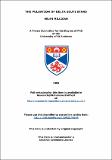Files in this item
The pulsation of Delta Scuti stars
Item metadata
| dc.contributor.advisor | Carson, T. R. (Thomas Richard) | |
| dc.contributor.author | Milligan, Helen | |
| dc.coverage.spatial | 175 p. | en_US |
| dc.date.accessioned | 2014-04-29T07:56:21Z | |
| dc.date.available | 2014-04-29T07:56:21Z | |
| dc.date.issued | 1989 | |
| dc.identifier | uk.bl.ethos.571488 | |
| dc.identifier.uri | https://hdl.handle.net/10023/4644 | |
| dc.description.abstract | A theoretical study of the pulsation of Delta Scuti stars is presented. A modified Henyey code is used to produce a grid of evolutionary models of population I composition, spanning the area of the Instability Strip on and near the Main Sequence (mass range 1.4 to 3.0 Mₒ ; log T > 3.8). Linear pulsation analysis of these models is carried out, using both adiabatic (Sturm Sequence) and non-adiabatic techniques. The results are found to agree closely, and to be consistent with the observed properties of real stars. A number of the models are subjected to non-linear analysis, using a modified Christy hydrodynamic code and the Carson opacities. A series of models is given an initial velocity kick of surface amplitude 10 km/s and profile varying as the fifth power of the fractional radius. The light curves of these models are found to be dominated by the fundamental mode and first harmonic. The first five eigenfunctions produced by the Sturm Sequence method are used as initial velocity profiles for another series of models, again with an initial kick of 10 km/s. The light curves of these models are found to be dominated by the frequency corresponding to the initially imposed mode of pulsation. For both sets of models, the light amplitudes are found to be larger than those of real stars. However, the indication of a number of criteria is that the models have not settled down to a final (smaller) amplitude. The first three Sturm Sequence eigenfunctions are used as initial velocity profiles for a smaller set of models with an initial kick of surface amplitude 3 km/s. Again, a final, settled amplitude is not achieved, but amplitudes are closer to those of real stars. The shapes of the light and velocity curves correspond closely to those of the same models with the larger kick. It is suggested that the form of the light curve may depend on the mode of pulsation. An attempt to use the shape of the light curves of real stars as a diagnostic for the mode of pulsation is unsuccessful, due to lack of data in the literature. A number of models depleted of helium are studied. One set has (X,Y,Z) = (0.88,0.10,0.02). The opacity table for this composition is obtained by interpolating between the Carson tables C312 and C402. The second set has (X,Y,Z) = (0.98,0.00,0.02), corresponding to table C402. Both sets of models continue to pulsate, and it is concluded that the region of hydrogen ionisation is an important source of driving in these stars. | en_US |
| dc.language.iso | en | en_US |
| dc.publisher | University of St Andrews | |
| dc.rights | Creative Commons Attribution-NonCommercial-NoDerivatives 4.0 International | |
| dc.rights.uri | http://creativecommons.org/licenses/by-nc-nd/4.0/ | |
| dc.subject.lcc | QB838.M5 | |
| dc.title | The pulsation of Delta Scuti stars | en_US |
| dc.type | Thesis | en_US |
| dc.type.qualificationlevel | Doctoral | en_US |
| dc.type.qualificationname | PhD Doctor of Philosophy | en_US |
| dc.publisher.institution | The University of St Andrews | en_US |
This item appears in the following Collection(s)
Except where otherwise noted within the work, this item's licence for re-use is described as Creative Commons Attribution-NonCommercial-NoDerivatives 4.0 International
Items in the St Andrews Research Repository are protected by copyright, with all rights reserved, unless otherwise indicated.


